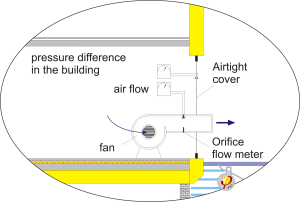Table of Contents
Airtightness test
Infiltration (gap ventilation) cannot ensure a continuous and adequate exchange of air (see Types of ventilation). Most newer buildings are so airtight, that a sufficunet exchange of air through gap ventilation for acceptable indoor air quality is not possible. On the other hand, the level of airtightness is not high enough to meet the structural protection requirements, i.e. they would have to be classified as “non-airtight” with leakage rates ranging from 4 to 10 h-1 often causing draughts and structural damage.
The situation in many countries can be suitably described in the following words:
Nowadays the level of airtightness in newly constructed buildings is usually too low for damage-free envelope components, and at the same time too high to allow for sufficient gap ventilation.
Air pressure test
The air pressure test, or the n50-value measures the total leakage through the building envelope. The n50-value (in h-1) describes the air changes at a differential pressure of 50 Pa. A differential pressure of 50 Pa (equivalent to 5 mm water column) is created between the inside of the building and the outside by means of a blower door test. The blower door consists if a compressor built into an opening in the envelope (e.g. a door) creating underpressure inside the building in order to detect leakages. The actual test involves a series of underpressure and overpressure measurements determining the leakage rate at a differential pressure of 50 Pa in relation to the air volume Vn50. Blower door tests are offered by competent engineering firms in many countries (for German providers go to www.flib.de). An air pressure test is essential for Passive Houses - it is part of the certification procedure.
Background: German legal requirements
In Germany, for example, a target value for new buildings was first introduced by the German Energy Saving Ordinance (EnEV) of 01.02.2001. Specific values for the pressurisation test (n50-values) should not exceed 3 h-1 without ventilation systems and 1.5 h-1 with home ventilation.
Experience with low-energy and Passive Houses has shown that better airtightness (i.e. a lower n50 value) should be strived for and realised; it's unexpensive and it has a lot of advantages, reduced energy demand is only one of these. The values required by the current EnEV regulations remained unchanged, however, mainly because of misguided lobby interests.
The Passive House
Much better values are regularly achieved for Passive Houses: n50 leakage rates may not be greater than 0.6 h-1 to comply with the certification criteria. In fact, values between 0.2 and 0,6 h-1 were achieved with built Passive Houses.




